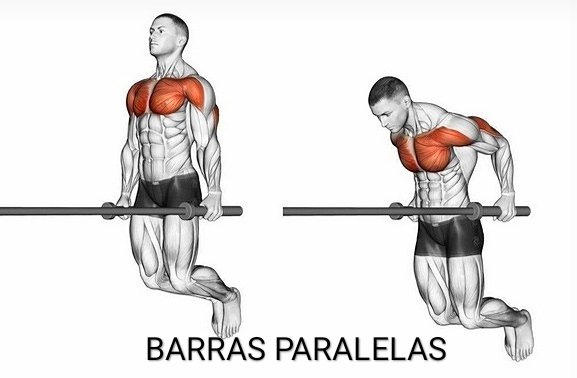Barras paralelas Calistenia by sergioclanrock

Las barras paralelas son ejercicios de calistenia que se originó en el entrenamiento de gimnasia y que ahora se utiliza ampliamente con los atletas y quienes deseen desarrollar cualquier actividad física logrando mayor desarrollo, fuerza y resistencia.
Con las barras paralelas se aumenta la capacidad de sostener tu propio peso, y por la gran variedad de ejercicios te ayudan a fortalecer, ganar masa y fibra muscular tonificando el cuerpo. Al elevar el cuerpo aumenta la tensión de los músculos y la necesidad de tensar las partes de los abdominales tonificándolos. Es muy importante mantener la columna recta así se evita lesiones por malas posturas.

Se trabajan y desarrollan los pectorales mayores, hombros, tríceps, antebrazos, bíceps y la parte abdominal. También la espalda se trabaja dependiendo de la velocidad al subir y bajar y la inclinación del cuerpo.
Flexionamos los brazos hasta llevar el pecho al nivel de las barras, el brazo forma un ángulo de 90 grados con el antebrazo. Es mejor no pasar de los 90 grados para evitar lesiones en la articulación del hombro.
Ahora nos elevamos, empujando con los brazos hacia abajo, hasta terminar con los brazos completamente extendidos.
Expirar al final del esfuerzo.

Variando la posición de nuestro cuerpo durante la ejecución del ejercicio, podemos lograr aumentar y disminuir la participación de los pectorales, hombros y tríceps respectivamente.
Si mantenemos el tronco lo más recto posible durante la ejecución del ejercicio, mayor será la participación de los tríceps .

Definitivamente es un ejercicio muy completo y adictivo. Con la correcta rutina más la constancia se logran resultados en muy corto tiempo.

Parallel bars are calisthenics exercises that originated in gymnastics training and are now widely used with athletes and those who wish to develop this activity achieving greater development, strength and endurance.
With the parallel bars, the ability to support your own weight is increased, and due to the wide variety of exercises they help you to strengthen, gain muscle mass and fiber, toning the body. Lifting the body increases the tension of the muscles and the need to tighten the parts of the abdominals by toning them. It is very important to keep the spine straight so that injuries due to bad posture are avoided.
The pectorals, shoulders, triceps, forearms, biceps and the abdominal part are worked and developed. Also the back is worked depending on the speed when going up and down and the inclination of the body. We flex our arms to bring the chest to the level of the bars, the arm forms a 90 degree angle with the forearm. It is best not to go over 90 degrees to avoid injury to the shoulder joint.
Now we rise, pushing with the arms downwards, until we finish with the arms fully extended. Expires at the end of the effort.
By varying the position of our body during the execution of the exercise, we can increase and decrease the participation of the pectorals, shoulders and triceps respectively.
If we keep the trunk as straight as possible during the execution of the exercise, the greater the participation of the triceps will be.
It is definitely a very complete and addictive exercise. With the correct routine plus perseverance, results are achieved in a very short time.
Imágenes y referencias :
https://calistenia.es/barras-paralelas/
https://www.ilovefit.org/musculo/ejercicios/fondos-paralelas-triceps/
https://issuu.com/efdgq/docs/enciclopedia_de_ejercicios_de_muscu/185
https://www.diariodeunfisicoculturista.com/2009/10/fondos-en-paralelas.html?m=1